Jun 8, 2022
How do you plan for a team as talented as the Avalanche?
Strong penalty killing and diligent defensive play are the keys to bogging down the deepest and most talented team in hockey, Travis Yost writes.
By Travis Yost
How do you beat the Colorado Avalanche?
It’s a front-of-mind question for everyone in hockey right now. That’s how much fear the Avalanche can strike into a team.
Their skater group is the deepest and most talented in hockey. If you had any reservations about that claim a week ago, the Avalanche put an exclamation point on it by sweeping the lively Edmonton Oilers to reach the Stanley Cup Final.
When the Avalanche are playing at their best, they look superhuman. They have high-end, superstar-level talents in Nathan MacKinnon and Cale Makar. The bulk of the lineup plays at a pace best described as frenetic. When the Avs are humming, they put most teams through the meat grinder.
This has been a sustained trend over time. No team has been more dominant than the Avalanche than the past three seasons, and that includes the (still alive) two-time Stanley Cup champions in Tampa Bay:
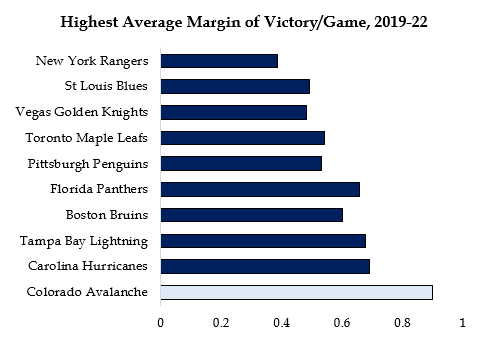
So yes, the Avalanche are terrifying. And whether it’s the New York Rangers or Lightning coming out of the East, they’ll have the same question: How do you plan for a team this talented? How can you win?
A goaltending heater from Andrei Vasilevskiy or Igor Shesterkin is one path, surely. A second path is the Avalanche imploding, which we have seen before. But absent good fortune, we must look at how other teams have had success against Colorado, and what that might mean the rest of the way.
To that end, I have split Colorado’s most recent regular season based on outcomes (52 games ending in wins versus 30 games ending in a shootout or a loss) to analyze the key underlying statistical measures. Like any team, we will see in games where Colorado struggled, their shooting percentages sank, and opponent save percentages surged. What other measures – specifically measures more within a team’s control over the course of a game – moved in a meaningful way?
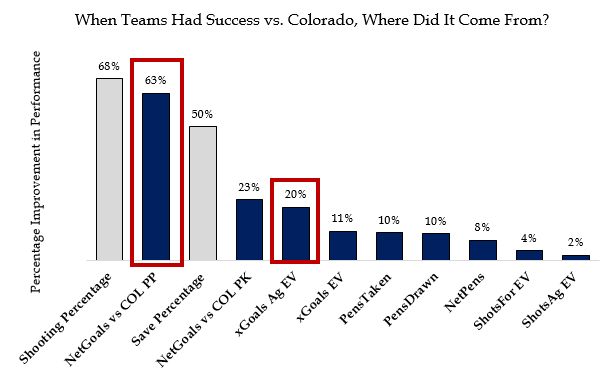
The two that pop off the page are team penalty killing, and team defensive play at even strength. Said differently, you cannot expect to win games against Colorado without slowing down their offence. In fact, it may be the only way to beat Jared Bednar’s team right now.
Let’s start with the penalty-killing numbers, because those are extraordinary.
We know the Avalanche get a friendlier whistle than the average team, but they also have a collection of skaters – including Tyson Jost (previously), MacKinnon, and Nazem Kadri – who clearly possess a skill when it comes to drawing penalties. Colorado’s ability to draw penalties in spades means ample opportunities for their power play. And when the power play gets opportunities, they send their hordes of skilled forwards over the boards to bury the undermanned opponent.
If you let Colorado’s power play cook, you probably will lose the game:
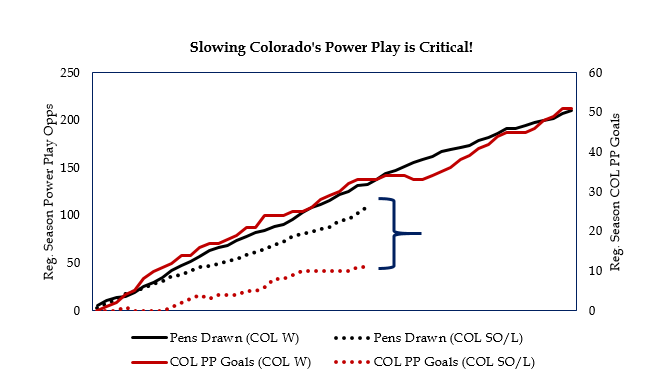
In regular-season outcomes where the Avalanche prevailed, they averaged +0.98 net power-play goals per game, a staggering number in a low-scoring league like the NHL. Compare that with games that ended in a shootout, or a Colorado loss. The Avalanche drew fewer penalties, yes, but they were significantly less productive in the opportunities they did have. In those 30 games they had just 11 net power-play goals, or +0.36 per game.
How does this look in practice? Let’s look at two games from the regular season. Up first, a late-March game against the Edmonton Oilers, where a pair of goals from Mikko Rantanen on the man advantage were the difference (via NST):
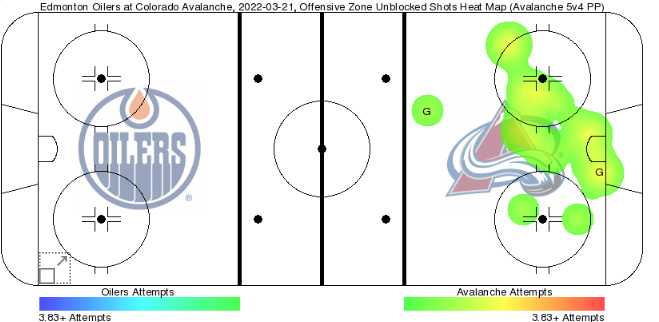
Compare that to a game a week later against a Coyotes team that not only had their way with the Avalanche power play but outscored them in the process. Look at how little volume is generated despite an abundance of ice time, and moreover, look at how little is generated from the interior:
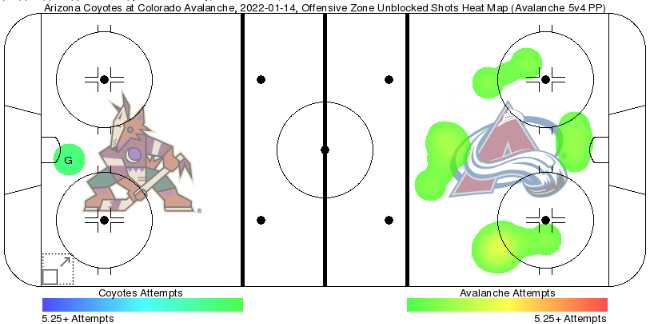
That brings to me to the other defensive point. The Avalanche are no slouch at even strength – this season, they scored 3.4 goals per 60 minutes there, third best in the league (behind Florida and Minnesota). The Avalanche do this in two ways: sustained offensive-zone pressure when they have gained the zone driving heavy shot volumes, and additional scoring chances coming through rush opportunities in transition. They are masters at both.
Teams that have slowed Colorado’s offence down – and we are talking expected goals here, not games where Avalanche shooters were merely unlucky – have had a much better chance at prevailing. That’s also true if you compare teams that have slowed Colorado’s offence down against teams who have had more success scoring against Colorado. The Avalanche can erase most deficits imaginable. But the Avalanche, when stymied offensively, can look human.
Look at the data binned into four categories – regular-season wins and shootouts/losses, as well as playoff wins and losses. There is a clear inverse relationship between a team’s ability to throttle the Colorado attack and their likelihood of winning the game.

If you are looking for a reason why the Blues gave the Avalanche some trouble in the second round, this says it clear as day.
This far into the season, there is little you can do tactically, and there is even less you can do personnel-wise. The rosters are what they are. But the preparation work for deployment, preferred matchups, and which strategy you can put in place to bog Colorado down – particularly in the neutral and offensive zones – should be underway.
In this era of hockey, offence wins championships. But if you’re the team that can pull off an upset against a juggernaut like Colorado, it’s going to happen on the defensive end. That’s been the case for some time now and will remain the case in the Stanley Cup Final.
Data via Natural Stat Trick, NHL.com, Evolving Hockey, Hockey Reference

